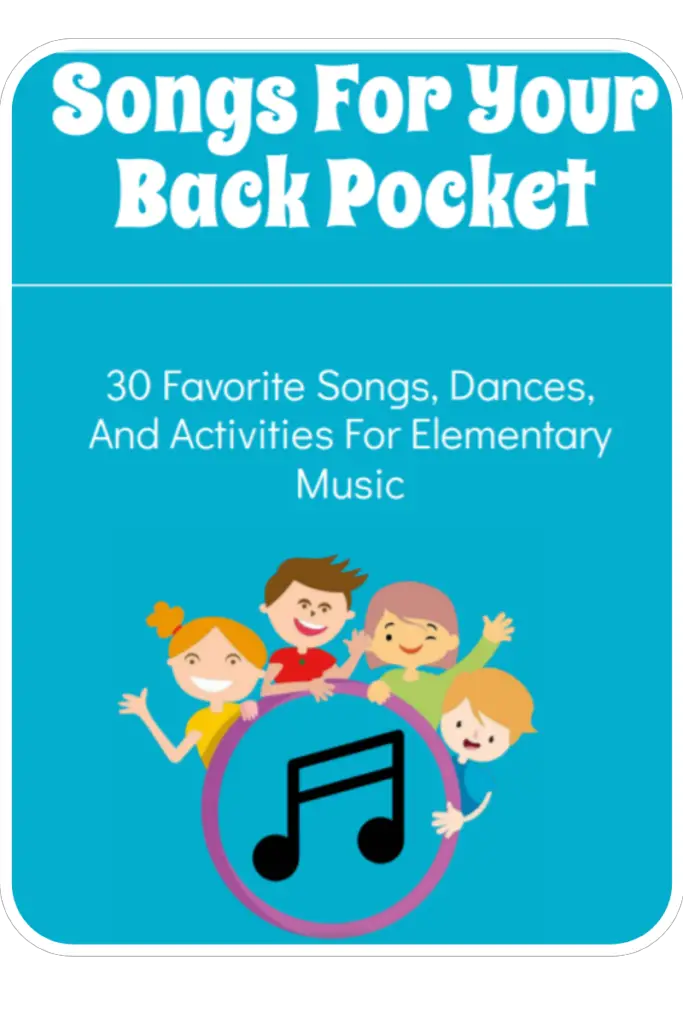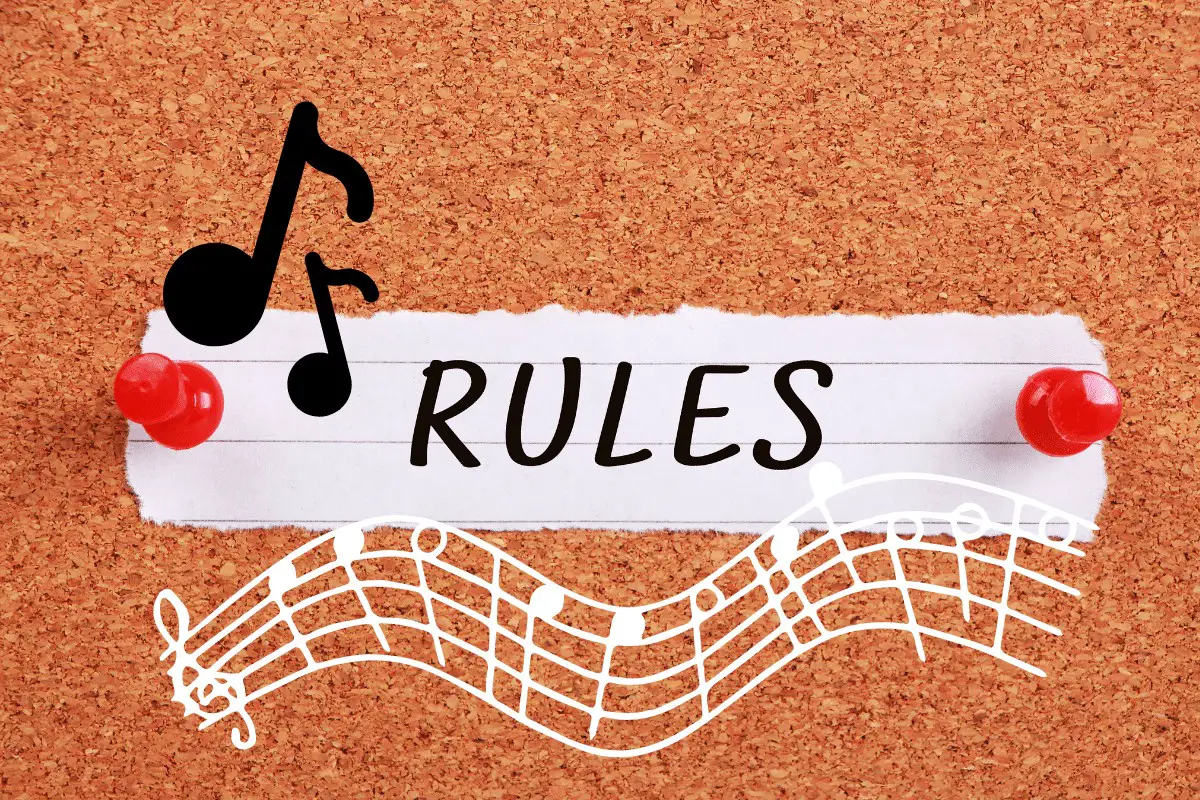One of the most important (if not THE most important) things you do to set up success for your school year in the music class is establishing rules and procedures.
These must be set up and settled well to keep the room running smoothly.
Of course, you’ll have to reteach each procedure as the year goes on, but getting it set from the get-go will lessen the behavior issues you have to deal with.
This is why I decided to offer some tips and tricks for music classroom rules & procedures.
Music classroom rules should be clear and taught at the beginning of the year. Make sure to have set procedures for normal classroom behavior, movement, instruments, and group work. Teach, model, dramatize, question, and review procedures throughout the year.
Of course, this is a huge topic I can’t cover completely here, but it should serve to give you a bit of a head start.

Save time with these 60 FREE Music Resources to use in your room right away!
Stop searching the whole internet to find good activities. I’ll help you cut to the chase with my favorite 60 FREE resources.
Table of Contents
Music Rules By Area And Topic
When it comes to rules, there are two general schools of thought with teachers and admin, and to be honest, both work pretty well.
First, you have a matrix or set of rules for each area in your classroom.
I bet your school has these displayed all over.
There would be one set for the hallway, one for recess, one for the bathroom, etc.
Admin and whole-school management prefer this way.
In the music room, this would translate to a set of expectations for all the activities you do, including:
- General classroom
- Movement
- Instruments
- Group work
- Listening
- Bathroom (if you have one)
The benefits of this method include setting rules for every step of your room. But it takes time to teach and can get a little confusing.
The other school of thought is to have one set of rules that is *just* vague enough to work for all the areas.
This means students only have to learn one set of rules, but you need to be conscious in teaching how these rules apply to each area of your room.
It takes a bit more effort on your part to connect the rules across all topics.
In this section, I’ll follow the second idea.
The first subsection will have my general rules, and then I’ll share how I apply them to every area.
Music Rules For The General Classroom
*This was inspired by the popular poster. I have no idea who started it, but I’ve seen it all over the place. M – Make Responsible Choices
With this rule, I talk about the only person who is in charge of YOU is YOU.
It’s my job to help and remind; it’s your job to try your best.
U – Use Equipment Safely
This one applies to all instrument and equipment needs.
I talk about how safety applies to the equipment (so it doesn’t break) and also how you don’t hurt yourself or others.
S – Show Kindness
Kindness is underrated.
We all need to lift each other.
Do your actions spell kindness?
Do you speak in a way you’d like to be talked to?
I try to stay positive, but things like name-calling or talking back would fit in here.
I – Involve Yourself In All Activities
This rule is aimed at those who don’t seem to want to do anything.
I talk about everyone needing to try everything. Otherwise, you’d never find new things you like.
I do draw a line at making kids do something all on their own.
It’s one thing for someone to refuse to play an instrument or at least mumble along with a song, but when you ask someone to perform as a solo or on their own, that pressure is a lot for some kids.
You don’t have to like everything, but you have to try everything at least a little bit.
C – Cooperate With Others
This rule is a bit tougher to codify.
I usually simplify it as “let everyone get their chance to shine.”
But it’s also a rule that involves how we work together.
It’s here I include things like raising your hand and such.
A big part of cooperation is in taking turns and sharing.
Music Procedures For Movement
M – Make Responsible Choices
Be aware of your body, what it’s doing, and how close you are to others.
U – Use Equipment Safely
Make sure your scarves, bean bags, etc. are being used so they A) don’t hurt others and B) don’t get broken.
S – Show Kindness
Not everyone moves the same way. Some people are naturally good at it, and some people need work.
We all need to encourage each other and create a safe, non-judgmental space.
I – Involve Yourself In All Activities
Moving feels uncomfortable to some people. It’s OK to be reluctant or nervous to try it.
But you need to give it a shot! You never know what you’ll enjoy.
C – Cooperate With Others
Take turns and let everyone get their fair share of time doing each job or movement.
Do your best so you don’t let the group down!
Music Expectations For Instruments
This one is hard to do because each instrument is unique.
Tweak the rules with specific examples for the specific instruments.
For example, using equipment safely looks quite different.
- Egg shakers – Keep them in your hand. Don’t let go and throw them. Don’t hit them on anything.
- Xylophones – Strike in the middle of the bar. Walk AROUND the instrument. Lift a bar with BOTH hands straight up.
- Drums with hands – Use a flat, high-five hand. Lift your hand only a couple of inches off the drum. Don’t drop the drum or smash it.
Adapt the following rules to suit your specific instrument at the time.
M – Make Responsible Choices
U – Use Equipment Safely
S – Show Kindness
I – Involve Yourself In All Activities
C – Cooperate With Others
Music Class Rules For Group Work
I love letting kids work in groups.
Small groups are an effective way to allow for more independence and creativity without leaving some kids in the dust or confused.
Group work is less effective than cooperative learning, but it’s the same idea (just without expectations).
Further Reading: Cooperative learning in music tips
M – Make Responsible Choices
Work on the project. Stay on task!
U – Use Equipment Safely
This would talk about how they treat pencils, papers, instruments, and whatever they use for their project.
S – Show Kindness
Everyone has their own strengths. If someone is struggling, give them help. Don’t make them suffer for it.
I – Involve Yourself In All Activities
Your group needs your help! Don’t let the others do all the work.
C – Cooperate With Others
Here is where I would cover a lot of the cooperative learning tactics to ensure successful work, including:
- Roles
- Group structures
- Format
- Gambits
- Talking cues
And more! Check out the link above for more details.

Tired of searching and searching for songs that work?
I’m saving you headaches and wasted time spent looking for good activities with this eBook of my 30 favorite songs, dances, and activities for elementary music. Get back to making music right now!
What Makes Good Procedures For The Music Classroom?
I totally understand if you want to tweak what I use above for yourself.
And you should!
I’m just one person with some experience, but our personalities aren’t the same.
Find what works for you and your kids.
Here are the general guidelines for setting up successful rules, procedures, and expectations for your classroom.
Note: I will say: that if your school uses the same language and rules for all classes, use those first.
Positive
Do you remember your rules from your elementary school days? I remember some of them, and they were usually something like this:
- Don’t talk without raising your hand.
- Don’t touch other kids without permission.
- No running in the halls.
- Have fun!
Yeah, it’s hard to “Have Fun!” when you keep hearing No, No, No all the time.
Frame your rules to be what they SHOULD do instead of what they should not do.
Clear
If your rule isn’t clear, it may as well not even be there.
“Have fun!” is very vague.
I know a lot of kids find running and hiding fun, but is that what you want?
“Involve yourself in all activities.” It’s a little impersonal, but it does a better job of moving the focus more specifically to being on-task.
Offering specific examples of the procedures in action is also helpful in terms of clarity.
Keeping it posted on a school music bulletin board or with some cool music room rules posters will do a lot too.
Easy To Remember
Make the rules easy to remember and say.
The MUSIC acronym works for me because it… well, it means MUSIC.
But if you want to simplify even more, go for it.
Reinforced By You
It doesn’t matter one tiny bit what rules you use if you don’t also reinforce and stick with them.
Apply them universally, with empathy, sure, but act every time.
Language Kids Can Understand
Use words your kids can understand or at least explain easily.
“Maintain a respectful and focused learning environment to ensure you and your peers receive an excellent education.”
This one may be good for middle school or high school students, but imagine this for Kindergarten? Crazy.
“Wait your turn to talk, and always raise your hand.”
This is the same idea but much better for the age level.
Tips For Teaching/Reteaching Music Rules
How you teach rules and procedures is also critical.
I try to review this book every year, and I recommend every else do as well.
There’s no better method and tips for teaching and reinforcing procedures.

Here is a quick rundown of my personal tips and takeaways, though.
Explain
First, state the rule and then explain what it means and looks like in a classroom.
The more specific you get, the better.
Example / Question
Provide the students with some scenarios (act them out on your own or with student help) and question on which procedures aren’t being followed (or are!).
Model (Individual, Small Group, Whole Group)
Do the task (such as going to instruments) and model it with one student.
Then, with small groups.
Then, as the whole class.
Be sure to offer specific compliments on what was awesome.
If needed, offer critique on what could be better.
Reinforce
Periodically and as needed, go through these steps again and again.
Rules and procedures are a yearly pursuit but don’t give up on them.
Not every class or student will get them, but most will if you show you’re clear and consistent.

Save time with these 60 FREE Music Resources to use in your room right away!
Stop searching the whole internet to find good activities. I’ll help you cut to the chase with my favorite 60 FREE resources.

